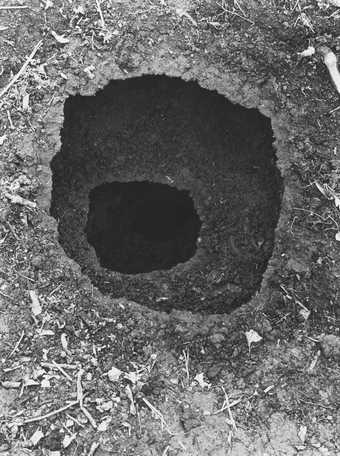This is the place where I found the red stone. I’ve found this red all over the world, in every country that I’ve worked in, and the reason blood is red is because of its iron content, so we share a connection with the stone. When I find it in Australia or Japan or France, I feel like I’m touching a bit of the red here too, and tapping into the same vein.
Well, the Source of Scaur snowball was made several years ago and was one of the series of paintings or drawings, watercolours, I guess, that were made from snowballs collected at the source of the Scaur. And they were mixed with stone pigments and earth pigments collected along the Scaur between where it rises and where it joins the Nith.
This is more or less how the one in the Tate was made, and it’s been out here about an hour now, and it’s just beginning to melt, and I can see a small pool beginning to form at the base; and at some point it will start to draw itself down the paper, which is on a slight slope. Instead of sitting and doing a watercolour, say, of the Lowther Hills or the hills round here, these paintings are actually made in a process that is the same way. You know, they are not representative: they are it. The snow is the place; the pigment is the place; the way they melt is how snow melts. The way the water, the paper, reacts with that melt, is how the landscape reacts to the effects of water.
I can control the rate of melt to some extent because of the heat of the room, but I would never, kind of, start tilting the paper and working it. For the drawing to have its integrity and strength as an artist, I have to kind of stand back; and that’s a really interesting situation for an artist to be in, where actually not making something produces a far stronger result.
I think that there is a core aspect to what I do, which is [the fieldwork 02:49] that I make every day. I go out and make something. And then there are all these other areas that I explore as well; you know, the installations in galleries, the video pieces that I’ve made; and then of course, all the large permanent sculptures that I’ve made. I like that studio element to my work. There’s not much of it. I very rarely work in here. And I do have a kind of a romantic idea of the studio. I think, you know, be a proper artist, and go to your studio every day, and all this having to go out there and deal with the elements; and yet somehow that side of things is perceived as being the romantic, you know. That’s the tough side of the art. This is the less tough; it’s easier
Any space, no matter how beautiful, is a dead space compared to outside, you know. I can only sustain installing or working inside for so long before I start drying up a bit, you know. Art has this amazing ability to show you what’s there. You know, you’re not this kind of observer; I’m a participant, and things are being continuously revealed through what I make; and that’s ultimately the reason I do it.

